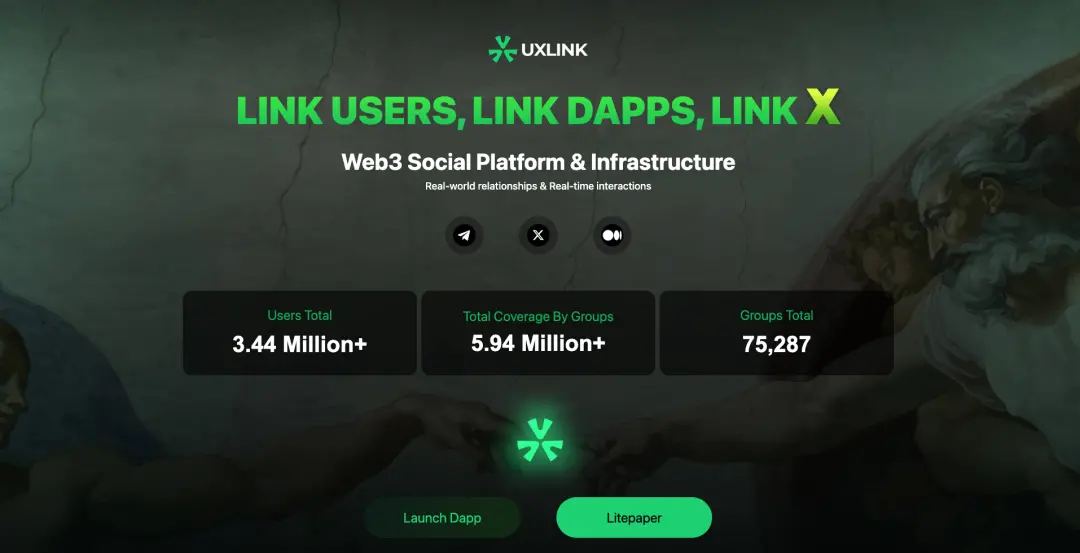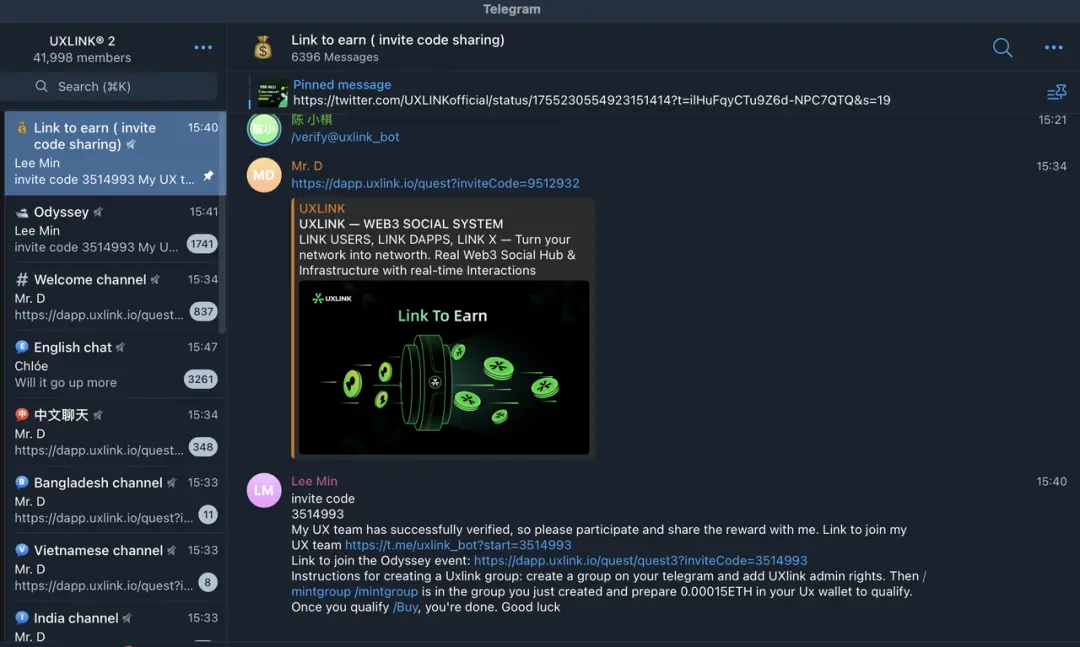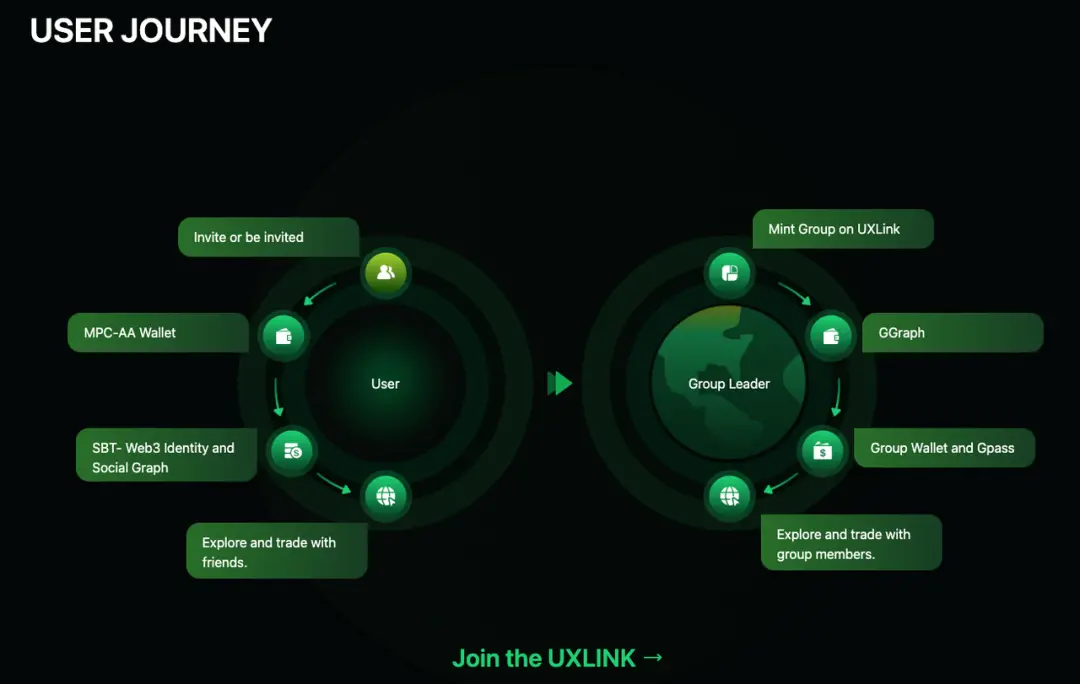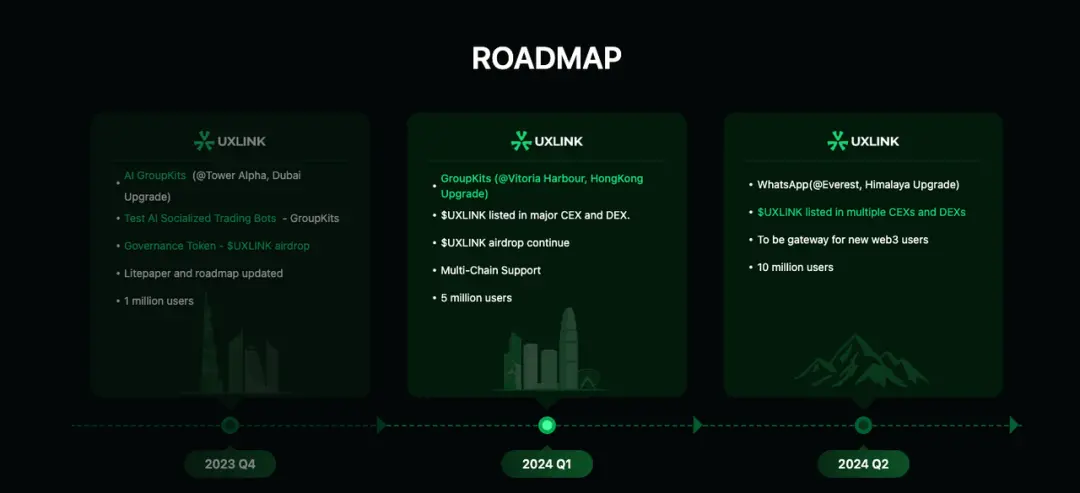Understanding the Web3 Social Monster in One Article: UXLINK
Author: Wilson Lee, Core Contributor of Biteye
Editor: Crush, Core Contributor of Biteye
If you want to know which project in the Web3 social field has garnered the most attention recently, it must be the social monster UXLINK.
UXLINK has established a Web3 social platform based on familiar social networks, allowing users to rapidly expand through their acquaintances. It provides deep social scenarios and token incentives to retain users and further grow, quickly gaining a strong user base in a short period.
Since its launch in April 2023, UXLINK has already amassed 3.4 million registered users, built over 75,000 group chats, and reached 5.9 million users through group chats. This also confirms the UXLINK team's profound understanding of Web3 social dynamics.

(Source: https://www.uxlink.io/)
01 Key Variable of Current Web3 Social: Familiar Social Relationships
Humans cannot escape social relationships. With the development of information technology, socializing and communication have become deeply digitalized. From instant messaging to sharing life updates, people's social relationships have been deeply integrated into digital scenarios.
In this paradigm shift of social interaction, we have witnessed the birth of killer applications like Facebook and WeChat.
This is largely due to network effects: the value of a platform increases as more people use it. This is particularly evident in the social domain, as people tend to congregate on platforms where their friends and family are, leading to the phenomenon of familiar expansion, where one user joins and their acquaintances follow, rapidly expanding the user base.
Web3 is considered the next generation of the internet, emphasizing decentralization, blockchain technology, and asset ownership, allowing users to truly own their online assets and providing a deeper digital experience.
Although current Web3 users are mainly concentrated in investment and speculation, as technology matures and application scenarios expand, it is expected that more mainstream users will flock in. The social domain, due to its strong network effects, is very likely to be the first to see killer applications and platforms emerge in the Web3 era.
Several Web3 social platforms have already gained significant recognition, such as Lens Protocol, Farcaster, and friend.tech.
Lens emphasizes ownership and portability of social media data, allowing users to control their data and migrate freely between different applications; Farcaster focuses on decentralization and user privacy, providing encrypted message transmission that allows users to communicate freely without platform restrictions;
Friend.tech emphasizes the assetization of social interactions, using NFTs to provide users with influence tokenization services. Although these applications have made significant innovations, their lack of emphasis on familiar social networks in the early stages may limit their rapid growth and retention.
In the Web1 and Web2 eras, the greatest products were all familiar social products like emails, Facebook, and WeChat. Will the kings of Web3 also belong to familiar social interactions?
The core scenario of Web3 is transactions, which inherently require trust. Web2 social platforms have already completed relationship building and trust establishment.
Web3 social provides a further experience at the asset and ownership level, so building directly based on familiar relationships is key to achieving mass adoption in the current context of a relatively small Web3 user base.
02 Products and Services: Growth, Retention, and Ecosystem
The entire UXLINK system can be divided into three layers: Dapp layer, protocol layer, and infrastructure layer.
Dapp Layer: User Growth and Retention
The Dapp layer provides users with core functions and services, including entry points, identity, and group functionalities.
- Entry Layer: Includes MPC and account abstraction wallets, providing users with a seamless entry into Web3. After launching the app, users will automatically register a wallet based on the Arbitrum network, eliminating the presence of private keys and mnemonic phrases, thereby improving user conversion rates.
- Identity: Includes DID/Profile (SBT). Users can create Web3 accounts through social applications like Telegram and WhatsApp, obtaining Web3 identities (DID) linked to their offline identities; UXLINK also employs zero-knowledge proof technology to help users build self-sovereign identities (SSI) and privacy-focused social relationships.
- Groups: Groups are the core landing scenario provided by UXLINK. Users can create group chats and expand based on their social graphs, earning rewards; they can also own and share data (social relationship data), allowing users to mint group IDs to assetize their social relationship data, achieving true ownership. In the future, AI assistant-related functions will also be provided to offer users a smoother social experience. Currently, UXLINK's groups are built as Telegram plugins, avoiding redundant development while allowing users to participate in the project through a familiar platform, eliminating user switching costs.
The "socialized" exchange, a combination of DEX and groups, is not yet fully completed but already has basic functions like swap, with logic similar to early Pinduoduo, allowing users to complete transactions through interaction, enhancing trust and adding fun.
The growth application, namely the LINK TO EARN engine, can acquire users and data for UXLINK while also serving third parties to assist in the growth of third-party Dapps.

In summary, UXLINK's core functionalities across the entry, identity, and group layers provide comprehensive tools for user socialization. UXLINK incentivizes users to invite acquaintances through Proof of Link (PoL), achieving growth. Coupled with familiar social features, relationship building, and monetization, new users can gain a friendly Web3 social experience with a very low barrier to entry, ultimately aiding in the mass adoption of Web3.

(Source: https://www.uxlink.io/)
Protocol Layer: Data Monetization, Empowering Ecosystem, Achieving Commercial Closure
The core of the protocol layer is the data from the Dapp layer, primarily aimed at developers. UXLINK's growth relies on the familiar relationship expansion of users, thus the Dapp layer will accumulate a large amount of social relationship data. The value of familiar relationship data is self-evident, as platforms like Pinduoduo and LinkedIn exemplify the utilization of familiar social relationships.
UXLINK provides comprehensive APIs for Web3 developers, enabling them to efficiently obtain and analyze user social relationship data from UXLINK, creating real commercial value. The revenue from this part will be shared between users and UXLINK, allowing the data accumulated by users to gain real value and achieve a commercial closure.
Infrastructure Layer: Further Building the Ecosystem
UXLINK has a hybrid on-chain and off-chain scalable technology architecture (EVM + IPFS + Hubs) to support mass adoption application scenarios, storing identity and relationship data on-chain (currently on Arbitrum) and processing complex business scenario data off-chain to support applications using the UXLINK Protocol. Additionally, UXLINK can provide decentralized storage and centralized data indexing services, mainly involving EVM chains (Ethereum Mainnet, Arbitrum L2 Chain, BNB Chain, Polygon, and Base Chain, etc.).
In the future, as the user base expands and ecosystem applications develop, UXLINK does not rule out the possibility of building its own social-specific chain to further strengthen the synergistic effects within the ecosystem and open up development space.
The above outlines UXLINK's product logic. The social track differs from other tracks, with the application layer and infrastructure layer being symbiotic and mutually reinforcing, capable of generating super applications while also serving as infrastructure for other tracks like gaming and DeFi.
03 Economic Model and Value Capture
UXLINK adopts a dual-token model, consisting of the utility token $UXUY and the governance token $UXLINK.
Utility Token $UXUY: Primarily used to incentivize community growth and interaction.
Earning: Users can earn $UXUY by inviting friends and contributing to the ecosystem. $UXUY will be stored in EVM-compatible wallets, with earlier users able to earn more $UXUY. As UXLINK's user base grows, the speed at which users earn $UXUY will exponentially decrease, highlighting the scarcity value of $UXUY. UXLINK refers to this mechanism as PoL (Proof of Link).
Burn Mechanism: $UXUY can be used to pay service fees (interaction fees within the ecosystem; UXLINK can also help users pay commissions with $UXUY). Of these fees, 3% - 15% will be burned, with the specific value depending on the governance decisions of the UXLINK community.
Governance Token $UXLINK: Primarily used for governance and capturing the value generated by UXLINK products.
Supply: $UXLINK has a fixed supply of 1 billion tokens.
Release: $UXLINK will be released after listing.
- Community Portion: $UXLINK tokens will be airdropped to active users, builders, and partners. Notably, there will be no lock-up period after the airdrop, providing immediate access.
- Partner Portion: Initially subject to a 3-month lock-up period, followed by a 2-year linear quarterly release. This means 12.5% will be gradually released each quarter over 8 quarters, promoting long-term participation.
- Team Portion: After a 6-month lock-up period, the team's $UXLINK tokens will undergo a 2-year linear quarterly release, with 12.5% released each quarter over 8 quarters, aligning with the project's long-term success.
- Treasury Portion: Flexibly released.
We can foresee that $UXUY will play an important role in ecosystem growth and expansion, allowing users to truly gain incentives while enabling new users to experience the core of Web3.
The existence of the burn mechanism also ensures that after user growth, $UXUY can maintain a relatively healthy circulation level. $UXLINK will also capture value in UXLINK's rapid growth.
(Source: https://docs.uxlink.io/uxuy-labs-api/whitepaper/white-paper)
04 Summary and Outlook
Mass adoption is one of the core issues facing Web3 at its current stage. In recent years, a large number of social, low-threshold wallet, and DID projects have cleared the barriers for traditional users to enter Web3 in terms of scenarios and entry points.
Recently, with the SEC approving the BTC ETF, Web3 has once again entered the sights of many traditional users. Applications that allow traditional users to seamlessly enter and deeply experience Web3 may land in this cycle. UXLINK has seized the core variable of familiar social interactions, using it as the underlying logic, while riding the wave of low-threshold infrastructure and the breakout of Web3, holding great potential for success in this cycle.
From the roadmap, we can clearly see the team's vision and confidence in Web3 mass adoption, and we look forward to UXLINK's subsequent performance.

(Source: https://www.uxlink.io/)









